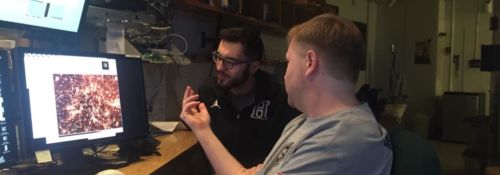
Pursuing Pulsars: Physics at a Liberal Arts College
Written By Kayla Mykeloff and Meghan Barnes
When he wasn’t representing Hillsdale College on the basketball court or traveling back home to Athens, Greece, Christos Giannakopoulos was in the basement of Strosacker studying physics. Christos is currently attending the University of Cincinnati for graduate school where he continues to study physics, but before graduating in 2019, he was one of fifteen students who have spent their summer studying with Dr. Timothy Dolch, assistant professor of physics, through Hillsdale’s LAUREATES science research program.
Dr. Dolch and Christos spent six weeks looking at pulsars and making guesses as to which would have wind nebulae surrounding them. At one point they traveled to Arizona to Kitt Peak National Observatory to try to find these nebulae.
“Christos was quite persistent,” Dr. Dolch said. “He has a very strong work ethic. A lot of athletes that go through the program have that experience. Sometimes you can look at these images, and your eye will see things that aren’t there. It’s a challenging project.”
Dr. Dolch said that pulsars help scientists detect gravitational waves and work as telescopes to see beyond our galaxy to find supermassive black holes. Visually, from optical telescopes, there are usually no pictures associated with pulsars, which are ordinarily observed with radio telescopes. This is where wind nebulae, and Christos’s research, come in.
“A nebula is created when the jets from the pulsars ionize the hydrogen around the pulsar,” Christos said. “Hydrogen glows at a specific wavelength of light. That wavelength is called Hα and happens when an electron jumps from a higher orbital to the first orbital in the hydrogen atom. We looked for those kind of nebulae around fifteen different pulsars all observed regularly by NANOGrav, an association of physicists that Dr. Dolch is a member of.”
“People dedicate their entire careers to studying pulsar wind nebulae,” Dr. Dolch added. “There are only nine known. There are currently 2,700 known pulsars, and the bulk of those have been discovered in the past decade, so there are many of these that no one has checked for nebula. If you find one, thats a big deal, a) because they’re cool looking, and b) because these bubble structures are a big contribution to our knowledge about the interstellar medium—the hydrogen between stars.”
After processing the pulsar images, Christos and Dr. Dolch did not discover any wind nebulae, but this just shifted the focus of their research.
“We ended up calculating what are called upper limits for those images,” Christos said. “This is done by using computer programming techniques. We used pictures taken three years ago from The Palomar Observatory in southern California of the Guitar Nebula. By using a specific program that I made, I was able to make it dim enough to find that critical value, which is the upper limit for each of the fifteen pulsars. If an Hα nebula exists in one of the pictures, it will be dimmer than a certain luminosity value (upper limit), which me and my advisor have provided.”
Christos said that one of the biggest takeaways from his summer research experience was that there is never enough time to do all the research you want to do. Or rather, the research will almost always be ongoing, as Dr. Dolch’s pulsar research continues to be.
“It’s hardly over,” Dr. Dolch said. “I’m getting more and more data on it all the time. This is the era of large collaborations in astronomy, which is nice because I can do all of this without having a lab. My ‘lab’ are these giant telescopes that any astronomer in the country can use (if his or her proposal is approved, of course). The data is way ahead of the theory. People will be looking through it for decades, which makes it nice for a small college like ours.”
Dolch mentioned that most graduate schools these days look for research experience in prospective students, so programs like LAUREATES and REUs (Research Experience for Undergraduates, which provides students from small schools the opportunity to spend ten weeks working with a professor at a larger university), are of great benefit to Hillsdale’s science students.
“Research is the most important thing in science,” Christos said. “It prepares the next generation of scientists and gives them the tools they will use in their future job. It takes the students out of the student-professor environment and brings them into one that requires social skills along with great communication to achieve a goal.”
Research also affords many students their first experience with computer coding, which is why Dr. Dolch teaches a physics course related to Python, a high-level programming language.
“Computer programming is a large part of what people do all day across the sciences,” he said. “Most people have done some amount of computer programming. And sometimes a student will be experienced, but a lot of students don’t have experience. Through the physics and math departments, we’re trying to bring back computer science, as well as through these research programs. It’s an incredibly marketable skill.”
Currently, Dr. Dolch’s focus is on Hillsdale’s new radio telescope, the Low-Frequency All-Sky Monitor, which is located in Hayden Park.
“I had three students work on it with me last summer, and five the summer before that, all through the LAUREATES program,” he said.
Interestingly, the Monitor project is really an electrical engineering project. Dr. Dolch said a lot of people think they can’t go to a liberal arts college and be able to go into engineering, but that’s not true. Many of Hillsdale’s physics students go into mechanical or electrical engineering.
Christos stuck with physics but agrees that the preparation physics students receive at Hillsdale is of great benefit.
“At Hillsdale, the student works in a familiar environment and communicates with familiar faces, which makes the adjustment to learning new skills easier,” he said. “The one-on-one student-teacher interaction makes this a special place for research.”